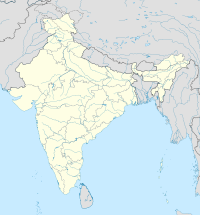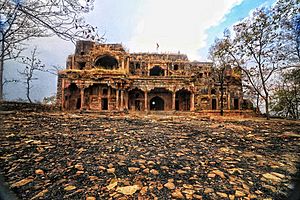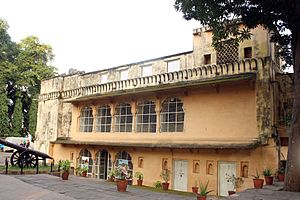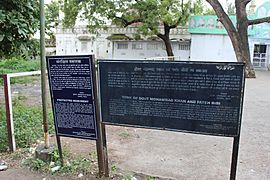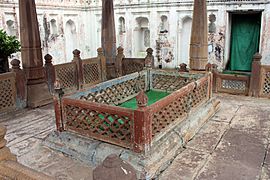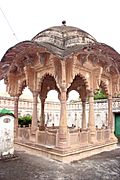Dost Mohammad of Bhopal facts for kids
Quick facts for kids
Dost Mohammad Khan
|
|
|---|---|
| Nawab of Bhopal | |
| Reign | 1707–1728 |
| Predecessor | None (Position Established) |
| Successor | Sultan Muhammad Khan (with Yar Mohammad Khan as regent) |
| Native name | دوست محمد خان ميرزئی خېل |
| Born | 1657 Tirah, Bangash district, Mughal Empire (Now Pakistan) |
| Died | 1728 (aged 71) Bhopal, Bhopal |
| Buried | Fatehgarh, Bhopal 23°15′N 77°25′E / 23.25°N 77.42°E |
| Noble family | Mirazi khel of Orakzai tribe |
| Spouse(s) | Mehraj Bibi Fatah Bibi Taj Bibi |
| Father | Nur Mohammad Khan |
| Military career | |
| Allegiance | |
| Service/ |
Nawab of Bhopal |
| Rank | Sowar, Faujdar, Subadar |
| Battles/wars | Mughal-Maratha Wars |
Dost Mohammad Khan (born around 1657, died 1728) was a powerful leader in central India. He is known for founding the Bhopal State and building the modern city of Bhopal. Today, Bhopal is the capital of the Madhya Pradesh state in India.
Dost Mohammad Khan was a Pashtun from a region called Tirah. He joined the Mughal Army in 1703 and quickly became a high-ranking officer. He was sent to the Malwa province in central India. After the Mughal emperor Aurangzeb died, the region became unstable. Khan started working as a mercenary, offering his fighting skills to local rulers.
In 1709, he leased the Berasia estate. He also worked for the small Rajput kingdom of Mangalgarh. He invited his Pashtun relatives to Malwa to build a strong team. Khan protected Mangalgarh from its neighbors. He married into the royal family and took over the state after the queen died without an heir.
Khan later helped local Rajput chiefs rebel against the Mughal Empire. He was injured in a battle but helped an injured Mughal nobleman, Sayyid Hussain Ali Khan Barha. This made him friends with the powerful Sayyid Brothers, who were very important in the Mughal court. With their support, Khan added more lands in Malwa to his state. He also helped Rani Kamlapati, a ruler of a small Gond kingdom. She gave him the village of Bhopal as payment. After her death, he took control of her kingdom. In the early 1720s, he turned Bhopal from a village into a strong, walled city. He then took the title of Nawab, which was used by Muslim rulers in India.
Khan's friendship with the Sayyid Brothers angered another powerful Mughal leader, Nizam-ul-Mulk. In 1724, the Nizam attacked Bhopal. Khan had to give up much of his land and send his son as a hostage. He also had to accept the Nizam's rule. In his later years, Khan became more spiritual. He and other Pashtuns who settled in Bhopal brought their culture and architecture to the city. The Bhopal State grew to be about 7,000 square miles. After Khan's death, his family ruled the state until it joined India in 1949.
Contents
Early Life and Challenges
Dost Mohammad Khan was born in 1657 in the Tirah region. This area was on the western edge of the Mughal Empire. His father, Nur Mohammad Khan, was an Afghan nobleman from the Mirazikhel clan of the Orakzai tribe.
When he was in his mid-20s, Dost Mohammad Khan was supposed to marry Mehraj Bibi. But she was later promised to his cousin because people thought Dost was too aggressive. In anger, Khan fought his cousin, which led to him being rejected by his family.
He then traveled to Jalalabad, near Delhi, where his Pashtun relatives lived. He stayed with his relative Jalal Khan, a Mughal military leader. During a celebration, Dost had a fight with one of Jalal Khan's sons and fought him.
After this, Dost Mohammad Khan decided to escape to Delhi, the Mughal capital. He met an old teacher, Mullah Jamali, who had taught him the Koran in Tirah. Mullah Jamali helped him in Delhi for about a year. Then, Khan decided to join the Mughal army. The Mullah gave him money and a horse to help him start.
Joining the Mughal Army
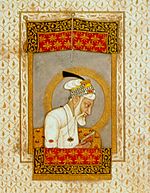
In 1703, Dost Mohammad Khan joined the Mughal army under Mir Fazlullah. Around 1704, he was sent to stop a rebellion by Governor Tardi Beg. Khan led the Mughal soldiers from Gwalior. Even though he was injured, Khan fought bravely and defeated the enemy general.
In 1705, Mir Fazlullah introduced Dost Mohammad Khan to Emperor Aurangzeb. Khan's diary says that Aurangzeb was impressed. The emperor gave him gold coins and told Fazlullah to give Khan an important command. Khan quickly rose through the ranks. He was sent to the Malwa province in central India. Malwa was not peaceful then. The Marathas, Rajput chiefs, and Muslim leaders were all fighting for power. The Mughals faced many revolts.
Emperor Aurangzeb died on February 20, 1707. Khan heard this news when he was in Bhilsa. A war of succession began among Aurangzeb's sons. Khan refused to join any side, saying he had promised loyalty to the late Emperor.
Becoming a Mercenary
After Emperor Aurangzeb's death, Malwa became even more chaotic. Dost Mohammad Khan became the leader of about 50 Pathan fighters. He started offering protection to local chiefs who needed help against attacks. These chiefs included Raja Reshb Das of Sitamau and Raja Anand Singh Solanki of Mangalgarh.
Mangalgarh was a small Rajput kingdom. The queen mother of Raja Anand Singh liked Dost Mohammad Khan very much. After the Raja died, she made Khan the "guardian" of Mangalgarh around 1708. His job was to protect the queen and her land. While working there, he married Kunwar Sardar Bai, the Raja's daughter. She later became a Muslim and was named Fatah Bibi. Khan married other women, but Fatah Bibi was his favorite.
For the next few years, Khan worked from Mangalgarh. He offered his fighting skills to anyone who would pay.
Building His Own Estate
In 1709, Dost Mohammad Khan decided to create his own land. Berasia, a small rented estate near Mangalgarh, was in chaos. It was often attacked by robbers. Dost Mohammad Khan decided to lease Berasia. He had to pay 30,000 rupees each year. His wife Fatah Bibi, from the Mangalgarh royal family, helped him pay. Khan appointed a judge, built a mosque and a fort, and put his loyal Afghan officers in charge.
Khan also tried to gain land in Gujarat but failed. He was defeated by a Maratha leader and even captured by his own rebel soldiers. His wife Fatah Bibi paid a ransom to free him.
Because of these struggles, Khan became distrustful of people. So, he invited his relatives from Tirah to Malwa. His father, his wife Mehraj Bibi, and five brothers arrived in Berasia in 1712. They brought about 50 tribesmen with them. His father died in 1715. His brothers were Sher, Alif, Shah, Mir Ahmad, and Aqil. All but Aqil died in later battles. The Pashtuns who came with Khan's family became very important in Bhopal. They were called "Barru-kat Pathans" because they first built their homes with thatched reeds.
Conflicts with Local Chiefs
The Rajput neighbors of Mangalgarh, led by the chief of Parason, formed an alliance. They wanted to stop the Rani of Mangalgarh from becoming too powerful. A long battle began between Mangalgarh and the Thakur's forces. During the festival of Holi, the Thakur suggested a truce. Dost Mohammad Khan agreed but sent a spy to the Thakur's camp. The spy reported that the Rajputs were celebrating and not paying attention. Khan broke the truce and attacked at night. He defeated the Rajput chiefs completely. Dost also conquered other nearby Rajput lands like Khichiwara.
In 1715, Khan had a conflict with another Rajput chief, Narsingh Rao Chauhan. Narsingh owned the fortified village of Jagdishpur near Berasia. Khan agreed to meet Narsingh to discuss a treaty. They met at Jagdishpur with 16 men on each side. Khan set up a tent by the Thal river. After lunch, Khan stepped out, pretending to order perfume and betel leaf. This was a signal for his hidden men to attack the Rajputs. After this event, Khan renamed Jagdishpur to Islamnagar. He made the fort stronger and made it his main base.
Khan's cousin, Diler Mohammad Khan, had also gained some land and started the Kurwai State. In 1722, he visited Berasia. He suggested that they work together to expand their lands and share everything equally. However, Dost Mohammad Khan had his cousin killed.
Dost Mohammad Khan also fought against Diye Bahadur, a Rajput general. Diye Bahadur's forces first defeated Khan's army. Khan was badly wounded and captured. He was treated well by the Rajputs. Diye Bahadur offered Khan a position in his army, but Khan refused. When asked what he would do if freed, Khan said he would fight Diye Bahadur again. Bahadur was impressed by Khan's bravery and released him. A few months later, Khan raised a new army and defeated Diye Bahadur.
Alliance with the Sayyid Brothers
The Sayyid Brothers were two powerful nobles in the Mughal Court after Emperor Aurangzeb died. They helped Aurangzeb's son Bahadur Shah I become emperor. Later, they became "king-makers," putting new emperors on the throne. They sent Nizam-ul-Mulk, another powerful leader, away from the Mughal court. The Nizam wanted to create his own independent state.
When the Mughals sent an army to stop the Rajput chiefs in Malwa, Dost Mohammad Khan sided with the Rajputs. In the battle, his men ran away, leaving him badly wounded. In his diary, Khan wrote that he woke up when jackals were biting him. He offered his last bit of water to an injured Mughal soldier who was trying to scare away the jackals. This soldier was Sayyid Hussain Ali Khan Barha, one of the Sayyid Brothers.
When Mughal soldiers came to rescue Sayyid Hussain Ali, Dost Mohammad Khan was also saved because of his kindness. Khan recovered under Sayyid Hussain Ali's care. Sayyid Hussain Ali offered to make him the Governor of Allahabad. Khan declared his loyalty to the Sayyid Brothers but refused the offer. He did not want to leave Malwa. He was sent back to Mangalgarh with gifts of gold coins, a sword, and horses.
Khan's close ties to the Sayyid Brothers later made Nizam-ul-Mulk angry. The Nizam later helped Emperor Muhammad Shah get the Sayyid Brothers killed.
Expanding His Territory
Soon after Dost Mohammad Khan returned to Mangalgarh, the queen of the kingdom died without an heir. Khan then took over the Mangalgarh territory. With the help of his loyal "Barru-kat" Pathan friends, Khan began to create his own state. He fought battles to add more lands, losing two of his brothers in the process. Many local chiefs accepted his rule without a fight.
While Khan was away from Mangalgarh, Mohammad Farooq Hakim, the Governor of Bhilsa, imprisoned his men and took his property. When Khan returned and confronted him, Farooq said he thought Khan had died in battle. He released the men but only returned half of Khan's belongings. This led to a battle near Bhilsa. Farooq's army had 40,000 Maratha and Rajput soldiers. Khan had only 5,000 Afghans and some Rajput soldiers. Khan lost his brother Sher Mohammed Khan, and his men fled. Dost Mohammad Khan and his loyal men had to hide. He saw Farooq riding an elephant in a victory parade. Khan dressed as one of Farooq's dead soldiers, hiding his face. Amid the loud victory drums, he climbed onto the elephant, fought Farooq and his guard, and claimed victory.
Khan also took control of several other areas, including Ashta, Debipura, Doraha, Gulgaon, Gyaraspur, Ichhawar, Sehore, and Shujalpur.
Rani Kamlapati and Bhopal
In the 1710s, the area around the upper lake of Bhopal was mostly home to Bhil and Gond tribes. Nizam Shah was the strongest Gond leader. He ruled from the Ginnor fort (Ginnorgarh). Ginnor was a very strong fort, high on a steep rock and surrounded by thick forest. Rani Kamlapati (or Kamlavati) was one of Nizam Shah's seven wives. She was known for her beauty and skills. Local stories say she was more beautiful than a fairy.
Nizam Shah was poisoned by his nephew Alam Shah, who wanted to marry Kamlapati. Kamlapati offered Dost Mohammad Khan a hundred thousand rupees to protect her and her kingdom and to get revenge for her husband's death. Khan accepted. Kamlapati tied a rakhi on his wrist, which is a sign of a sister asking her brother for protection. Khan led a combined army of Afghan and Gond soldiers. They defeated and killed Alam Shah. The slain king's land was added to Kamlapati's kingdom. The Rani did not have all the money, so she paid him half and gave him the village of Bhopal for the rest. Khan also became the manager of Kamlapati's state. He was almost the ruler of the small Gond kingdom. Khan remained loyal to the Rani and her son Nawal Shah until her death.
In 1723, Rani Kamlapati died. Dost first pretended to be loyal to her son Nawal Shah, who controlled the Ginnor fort. He was invited to live in the fort. Khan disguised 100 of his soldiers as women. He sent them to Ginnor in dolis (covered palanquins) that were supposed to carry his wife and family. Nawal Shah's guards let the dolis inside without checking. At night, Khan's soldiers fought Nawal Shah and his guards. Khan then took control of the Ginnor fort and all the lands of Kamlapati's kingdom.
Developing Bhopal City
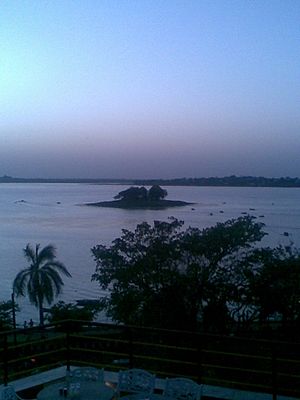
Dost Mohammad Khan ruled his state from his capital at Islamnagar. When Kamlapati died, Bhopal was a village of about 1,000 people, south of Islamnagar. One day, during a hunting trip, Dost Mohammad Khan and his wife Fatah Bibi rested in Bhopal village. Dost fell asleep and dreamed that an old saint told him to build a fort. He told his wife, who asked him to build a fort there. This led to the building of Fatehgarh fort, named after Fatah Bibi. The first stone was laid on August 30, 1723. The fort was later expanded to surround the village of Bhopal. It was never captured by an enemy.
The first mosque in Bhopal, the Dhai Seedi Ki Masjid, was also built then. This allowed the fort guards to perform namaaz (prayers). A handwritten copy of the Quran with a Persian language translation was kept at the fort. Dost Mohammad Khan and his family slowly started using Bhopal as their main base, though Islamnagar was still the official capital.
Between 1720 and 1726, Dost began building a protective wall around the city. Bhopal changed from a village to a fortified town with six gates:
- Ginnori (the gate leading to Ginnorgarh)
- Budhwara (Wednesday gate)
- Itwara (Sunday gate)
- Jumerati (Thursday gate)
- Peer (Monday gate)
- Imami (used for Tazia processions during Muharram)
Bijay Ram, a Rajput chief, became the dewan (chief minister) of Dost's state. Since he was a Hindu, he helped Dost gain the trust of the local people.
Conflict with Nizam-ul-Mulk

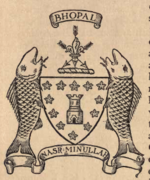
By the early 1720s, Dost Mohammad Khan had become a ruler of a small state. After Emperor Aurangzeb died, the Malwa region was claimed by the Marathas, some kings of Rajputana, and the Mughals. Dost Mohammad Khan recognized Mughal authority by sending gifts and letters to the Mughal Emperor. The Emperor, who was controlled by the Sayyid Brothers, gave him the title Nawab Diler Jung. Dost also paid the Marathas chauth (tribute) to prevent their attacks.
In 1719, the Sayyid Brothers fought Emperor Farrukhsiyar and later put other emperors on the throne. Muhammad Shah became emperor with the Sayyid Brothers' help. The Sayyid Brothers and Nizam-ul-Mulk were becoming enemies. Dost Mohammad Khan knew how powerful Nizam-ul-Mulk was. However, he allied himself with the Mughal Court, which was controlled by his friends, the Sayyid Brothers.
In 1720, the Sayyid Brothers sent a Mughal army against Nizam-ul-Mulk in Malwa. Dost Mohammad Khan sent his brother Mir Ahmad Khan to support this army. The Mughal force was defeated by the Nizam, who had Maratha support. Mir Ahmad and other generals were killed. Dost Mohammad Khan's forces retreated and were attacked by the Nizam's Maratha allies. This made both the Nizam and the Maratha Peshwa angry at Dost.
Later, Nizam-ul-Mulk helped Emperor Muhammad Shah get the Sayyid Brothers killed. After gaining control of the Deccan region, the Nizam decided to punish Dost Mohammad Khan for supporting the Sayyid Brothers. On March 23, 1723, he sent an army to Bhopal. Khan fought from his fort. After a short siege, Khan agreed to a truce the next day. He held a grand banquet for the Nizam and gave him an elephant. He also named a hillock Nizam tekri (Nizam's hillock) in his honor. Khan agreed to give up part of his land, including the Islamnagar fort. He also paid a large tribute of ten lakh (one million) rupees and promised more later. He was also forced to send his 14-year-old son, Yar Mohammad Khan, to the Nizam's capital, Hyderabad, as a hostage.
The Nizam took control of Bhopal. He appointed Dost Mohammad Khan as a fort commander. In return for a fort, a payment, and a promise of troops, the Nizam gave Khan a decree recognizing his right to collect taxes from the territory.
Death and Legacy
In his final years, after his defeat by the Nizam, Khan became much calmer. He found inspiration in Sufi mystics and became more spiritual. He encouraged scholars, doctors, and artists to settle in Bhopal. Many Pashtuns also settled in Bhopal during his rule because the area was peaceful.
-
Mausoleum of Dost Khan at Bhopal
Dost Mohammad Khan died from an illness in March 1728. It is said he had 30 wounds on his body from all the battles he fought. He was buried in the Fatehgarh Fort next to his wife Fatah Bibi.
Dost Mohammad Khan had 5 daughters and 6 sons (Yar, Sultan, Sadar, Fazil, Wasil, and Khan Bahadur). He had several wives. Four of his children were from his first wife, Mehraj Bibi. Fatah Bibi, his favorite wife, did not have children but had an adopted son named Ibrahmin Khan. Khan had three children from Jai Kunwar (later Taj Bibi).
The court of Bhopal chose Khan's younger son, Sultan Mohammad, as his successor. Sultan Mohammad Khan was only 7 or 8 years old. The Nizam disagreed with this choice. He sent Dost's hostage son, Yar Mohammad Khan, to Bhopal with a thousand horsemen. Yar Mohammad Khan was Dost's eldest son. The Bhopal court did not want to give him the title of Nawab. However, Yar Mohammad was allowed to act as the regent (a person who rules for a young king).
The Bhopal State later became a protectorate of the British India. Dost Mohammad Khan's descendants ruled it until 1949. Then, it joined independent India. Many of Dost Mohammad Khan's descendants later moved to Pakistan.


